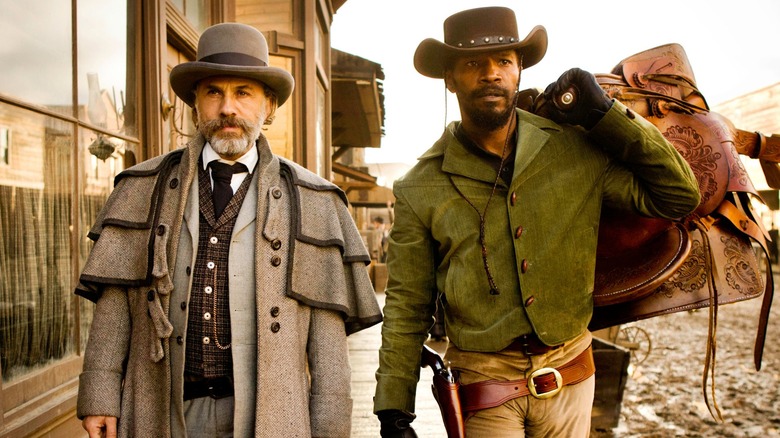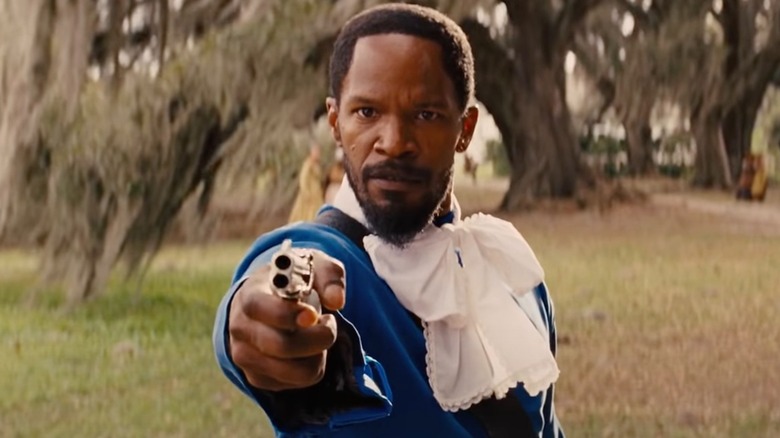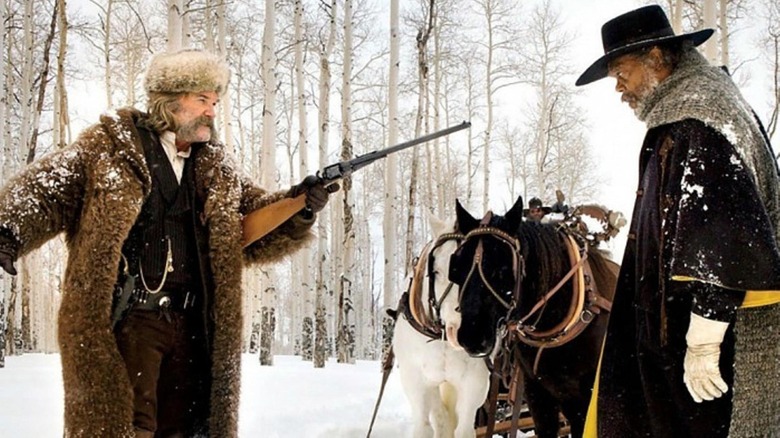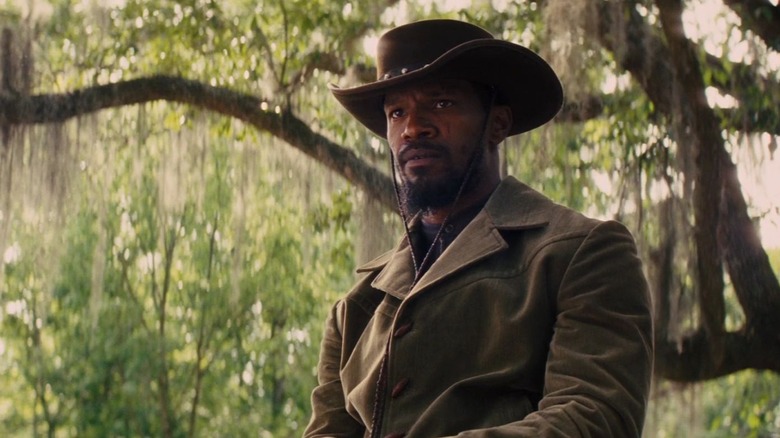The Django Unchained Sequel Quentin Tarantino Never Made (And The One He Kinda Did)
In a lot of ways, the release of Quentin Tarantino's 2012 film "Django Unchained" suggested a continuation of much of what he'd explored since the release of his monumental two-part film, 2003 and 2004's "Kill Bill" saga. He was exploring revenge, not just as a plot point but as an aesthetic unifier of many different filmmaking styles, whether it was the Kung Fu and anime influences of "Kill Bill," the '70s car chases of "Death Proof," or the World War 2 panorama of "Inglourious Basterds." Across all of those movies was a single overriding inspiration: the Italian, or Spaghetti, Westerns of the '60s and '70s.
"Django" was Tarantino's first movie to exist wholly in that vein. The theme of revenge was a major element for that film, and not just for its literal story of freed slave Django (Jamie Foxx, who found himself haunted by the movie's production locations) locating and rescuing his captured wife from plantation owner Calvin Candie (Leonardo DiCaprio). It was also, in line with "Inglourious Basterds," a cinematic means of righting historical wrongs in a particularly Tarantino way, giving a victim of the American slavery system the tools to destroy it. Violently.
While "Django Unchained" took place in the South, it was absolutely meant to evoke the feeling of a Spaghetti Western, whether in the music, sound effects, shot choices, costuming, amount of violence, and narrative tradition. From his previous films, it was clear Tarantino had adored that type of movie, and nobody was surprised when, following the release of "Django," he was set to make another one: 2015's "The Hateful Eight." More surprising was that early in that film's development, he had intended for it to be a direct follow-up to "Django," even starring the now-iconic character as the lead.
Revenge fantasies
"Django Unchained" was a reckoning with the evils of chattel slavery from one of America's most significant filmmakers, but it also resulted in some controversy as a result of Quentin Tarantino's point-of-view. No less a filmmaker than Spike Lee, per Rolling Stone, took issue with Tarantino's "disrespectful" framing of slavery and the antebellum South as a setting of Spaghetti Western adventures. In some ways, it's not entirely different from the pulpy caricatures of "Inglourious Basterds," which treated the genocide of Jews in Europe with a similar degree of horror and pop culture-refracted Tarantino pizzazz.
Tarantino, rather than dealing with the concept of slavery in the form of an "issue movie," told the Telegraph in 2007 that he was developing a Spaghetti Western-style movie dealing with those themes. To his mind, the best way to engage with America's sordid history was to play it as a genre collage, where horror and adventure and extreme violence came together. At the center of the movie was Jamie Foxx's Django, whom Tarantino hoped could become a folkloric pulp hero in the vein of Zorro. The movie implies that Django as a character is in line with the Spaghetti Western protagonist of the same name, by giving him a portentous encounter with Franco Nero, the star of 1966's "Django."
Regardless of whether or not the sheer entertainment value of "Django Unchained" made it exploitative of one of America's greatest sins, the movie was a hit, becoming Tarantino's most successful film. Tarantino might not have succeeded in honoring the victims of slavery, but his dream of making a Black American hero had come to be. Now, the question became where to take the character next.
White Hell
As a Spaghetti Western protagonist, Django could go anywhere. In those movies, the West was malleable, a handful of barren frontier towns at the edge of civilization. Shot in Europe, they often bore little resemblance to the classical American Westerns of the '40s and '50s, and they didn't comment on the failures of that genre to deal with real American history. They had their own horrible recent history to deal with, and the geographical extremes of the West presented a staging ground for it, which is what attracted a young Quentin Tarantino to the genre. Only he actually would turn it inward on America.
He followed up his reckoning with slavery in "Django Unchained" with an even more nihilistic, acidic confrontation with American race relations in 2015: "The Hateful Eight." For a movie that almost got canceled before production began, it proved to be one of Tarantino's strangest and most disturbing efforts.
Starring Samuel L. Jackson as Major Marquis Warren, a Black bounty hunter snowed in with a handful of possibly extremely violent Western characters, it lacked the gunplay and expertly staged action of "Django." Instead, it zeroed in on Tarantino's thorny and theatrical dialogue, featuring little more than characters simply talking over long stretches in a snow-swept inn during a blizzard. Instinctively, you trust Warren over the others, more or less until you get to his own description of a horrifying violent act he'd committed.
While it's an ensemble piece, "The Hateful Eight" shines brightest when Warren takes the stage. Tarantino gives Warren the biggest role in the plot, and a heroic role in the midst of a horrific conspiracy inside the inn, Minnie's Haberdashery. Much of that is probably an artifact of Tarantino's first concept of the movie: "Django in White Hell."
Pulp heroes
As Collider reported, "Django in White Hell" wouldn't be a movie exactly. It would be a Django paperback written by Quentin Tarantino, in line with the novelization he would one day write for his 2019 film "Once Upon A Time In Hollywood." As a writer over everything else, Tarantino has always talked up the opportunity to author novels and books of film criticism — this would have been his first foray. It's easy to imagine Django in the shoes of Marquis Warren. All that would need changed is some of the more vile backstory of the character, and a bit more heroism from him.
Of course, "The Hateful Eight" required something hateful. As Tarantino said, "you shouldn't have a moral center when it comes to these eight characters," and Django would have corrupted that view. Subtracting Django and adding Warren clarified what the movie could be for Tarantino, but that didn't mean Django would be ignored. Instead, Tarantino found another continuation for the story of his new pulp hero: a partner with Zorro.
Zorro was of course a legendary hero, having been created nearly a century before Django and standing in as a hero of Spanish California. According to The Guardian, it was in reading writer Matt Wagner's run of "Zorro" comics that Tarantino realized Django could be translated to that medium, which led to the birth of "Django/Zorro," a seven-issue run of comics. As a follow-up to "Django Unchained," it's a little lacking, with Tarantino's fairly limited involvement becoming clear early on. But for anybody who fell in love with the character, it's a sensible successor, one that makes it clear that Tarantino's desire to turn Django into a pulp hero wasn't misplaced.



